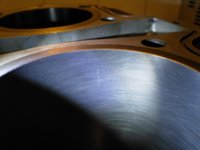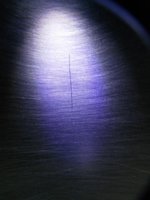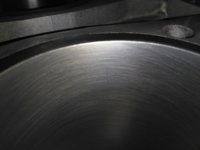I did upload this at facebook. But i would like the see what some gurus on here think about it.
Not sure if the scratch was there when i left the company who bored the cylinder, or if i have made it. I've finished filing piston rings for the other bore, which in this case does not have any scratches like this even after ive put rings down that bore x10 times.
Its bored to 700cc, i can feel the scratch very sligthly but it does not stop my nail from moving over. I know its hard to say "your fine to run" but i would like to hear if someone else has ignored such a small scratch and went ahead. One picture is taken through o loupe, where it may look like its a crack. I doubt it, but i will check if i got a magnaflux at work. Other than that my options are, rehone? or run.. Lets hear it.
Not sure if the scratch was there when i left the company who bored the cylinder, or if i have made it. I've finished filing piston rings for the other bore, which in this case does not have any scratches like this even after ive put rings down that bore x10 times.
Its bored to 700cc, i can feel the scratch very sligthly but it does not stop my nail from moving over. I know its hard to say "your fine to run" but i would like to hear if someone else has ignored such a small scratch and went ahead. One picture is taken through o loupe, where it may look like its a crack. I doubt it, but i will check if i got a magnaflux at work. Other than that my options are, rehone? or run.. Lets hear it.



